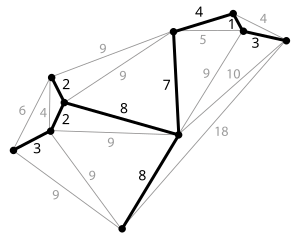
A minimum spanning tree (MST) or minimum weight spanning tree is a subset of the edges of a connected, edge-weighted undirected graph that connects all the vertices together, without any cycles and with the minimum possible total edge weight.[1] That is, it is a spanning tree whose sum of edge weights is as small as possible.[2] More generally, any edge-weighted undirected graph (not necessarily connected) has a minimum spanning forest, which is a union of the minimum spanning trees for its connected components.
There are many use cases for minimum spanning trees. One example is a telecommunications company trying to lay cable in a new neighborhood. If it is constrained to bury the cable only along certain paths (e.g. roads), then there would be a graph containing the points (e.g. houses) connected by those paths. Some of the paths might be more expensive, because they are longer, or require the cable to be buried deeper; these paths would be represented by edges with larger weights. Currency is an acceptable unit for edge weight – there is no requirement for edge lengths to obey normal rules of geometry such as the triangle inequality. A spanning tree for that graph would be a subset of those paths that has no cycles but still connects every house; there might be several spanning trees possible. A minimum spanning tree would be one with the lowest total cost, representing the least expensive path for laying the cable.
- ^ "scipy.sparse.csgraph.minimum_spanning_tree - SciPy v1.7.1 Manual". Numpy and Scipy Documentation — Numpy and Scipy documentation. Retrieved 2021-12-10.
A minimum spanning tree is a graph consisting of the subset of edges which together connect all connected nodes, while minimizing the total sum of weights on the edges.
- ^ "networkx.algorithms.tree.mst.minimum_spanning_edges". NetworkX 2.6.2 documentation. Retrieved 2021-12-13.
A minimum spanning tree is a subgraph of the graph (a tree) with the minimum sum of edge weights. A spanning forest is a union of the spanning trees for each connected component of the graph.